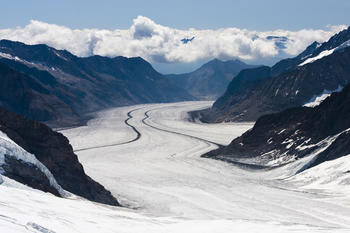Icy Death
Mathematician at Freie Universität Berlin and Glaciologist at ETH Zurich Reconstruct Historical Death in the Snow with Glacier Simulation
Mar 18, 2014
One day in March 1926 four young men, three of whom were brothers, did not return from a ski tour on the Great Aletsch Glacier. The remains of the three brothers were found 86 years later by two British mountaineers. On the basis of where the bones were found and using a computer model, mathematician Guillaume Jouvet from Freie Universität Berlin and glaciologist Martin Funk from ETH Zurich were able to retrack the path the bodies must have taken and localize the area where the men must have died and been picked up by the glacier.
At midday on a March day in 1926, four men, three of whom were brothers, reached the Great Aletsch Glacier, which with its 23 kilometers is the longest glacier in the Alps. According to eyewitness accounts, they set off in the afternoon. It was the last time that anyone saw them alive. The most likely explanation is that they were caught in a snowstorm and froze to death. In June 2012, 86 years later, two British mountaineers found the remains and equipment of the three brothers. The body of the fourth man remains missing. Based on the location of the bones and using a computer model, Guillaume Jouvet, who works in Professor Ralf Kornhuber's group at Freie Universität Berlin, and glaciologist Martin Funk from ETH Zurich, were able to localize the area where the men most likely died and were picked up by the glacier. The computer model used for the reconstruction was designed by Jouvet in 2010 while he was working on his doctorate at ETH Lausanne.
Originally Jouvet and Funk had created the model to gain a better understanding of the growth and shrinkage of the Aletsch Glacier during the age of climate change. Their simulation was the first three-dimensional presentation of the flow field of the Great Aletsch. The model takes into account the temporally and spatially varying flow rate of the ice. Using the model they found that the three bodies must have been transported in the ice with an average speed of 122 meters per year, or a total of 10.5 kilometers. They were able to localize the area where the mountaineers disappeared and demarcate it to an area of 1600 by 300 meters.
Jouvet and Funk think they might be able to use the model to help solve other cases, for example, the Dakota C-53 aircraft that in November 1946 crash-landed on the Gauli Glacier in the Bernese Alps and disappeared in the ice after the passengers were rescued. With the help of the simulation, the researchers may be able to forecast when the military aircraft will be released from the glacier. So far, there has been no further trace of the fourth young man who had accompanied the three brothers on that day in 1926.
Literature:
Guillaume Jouvet, Martin Funk (2014): Modelling the trajectory of the corpses of mountaineers who disappeared in 1926 on Aletschgletscher, Switzerland,Journal of Glaciology 60 (220), p. 255–261.

